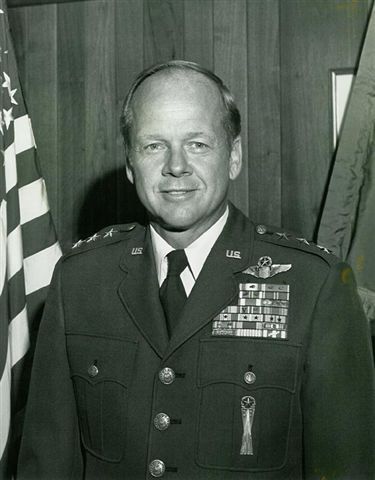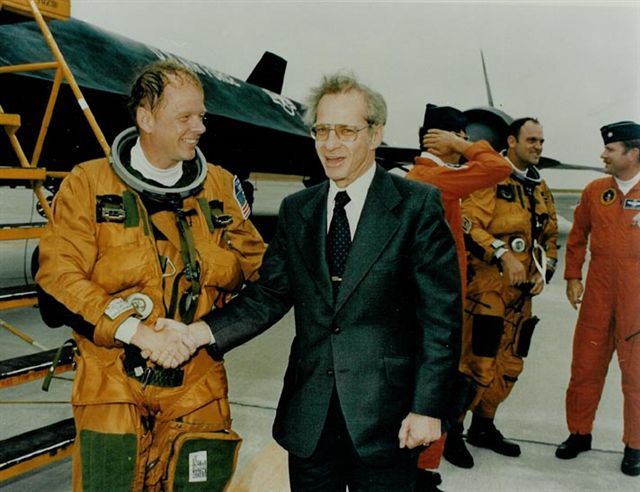


 |
 |
 |


U N I T E D S T A T E S A I R F O R C E

![]()

![]()
![]()
![]()
![]()
![]()
![]()
![]()
![]()
Retired Sep. 1, 1981.
Lieutenant General Lloyd R. Leavitt Jr. is vice commander in chief of the Strategic Air Command, Offutt Air Force Base, Neb. As vice commander in chief, he fulfills the responsibilities of the SAC commander in chief in his absence. He is also the commander's principal adviser in the formulation of SAC policies, plans and directives.
General Leavitt was born in 1928, in Alpena, Mich., and graduated from Alpena High School in 1946. He was appointed to the U.S. Military Academy at West Point, N.Y., and graduated in 1950 with a commission as a second lieutenant and a bachelor of science degree in engineering. He received a master's degree in public administration from The George Washington University, Washington, D.C., in 1964; graduated from Squadron Officer School at Maxwell Air Force Base, Ala., in 1956; and the National War College, Fort Lesley J. McNair, Washington, D.C., in 1967.
After graduation from the academy, he attended flying training school at Williams Air Force Base, Ariz., and was awarded pilot wings in 1951. During the Korean War General Leavitt served in South Korea as a pilot and flight commander with the 58th Fighter-Bomber Wing. He flew 100 combat missions in F-84s.
General Leavitt was assigned to Headquarters Far East Air Forces, Fuchu Air Station, Japan, in the Directorate of Requirements from August 1952 to November 1953. He then returned to the United States and served as a flight commander in the 508th Strategic Fighter Wing at Turner Air Force Base, Ga. In 1957 he became a U-2 pilot and later chief of standardization in the 4028th Strategic Reconnaissance  Weather Squadron at Laughlin Air Force Base, Texas.
Weather Squadron at Laughlin Air Force Base, Texas.
He entered B-52 training in October 1960 and was assigned to the first B-52H unit - the 524th Bombardment Squadron at Wurtsmith Air Force Base, Mich. In 1962 he transferred to the 379th Bombardment Wing as chief, Training Operations Branch and later was assigned to the 40th Air Division at Wurtsmith Air Force Base as an operations staff officer.
From November 1962 to July 1966, General Leavitt was assigned to Headquarters U.S. Air Force, Washington, D.C., in the Office of the Deputy Chief of Staff, Plans and Operations, as an operations staff officer working in studies and analysis.
Following graduation from the National War College in August 1967, General Leavitt transferred to Germany where he was assistant deputy commander for operations of the 36th Tactical Fighter Wing at Bitburg Air Base, and later director of readiness inspection for the inspector general, Headquarters U.S. Air Forces in Europe, Lindsey Air Station, Germany.
The general went to Thailand in April 1970 and served as vice commander, 8th Tactical Fighter Wing at Ubon Royal Thai Air Force Base until his appointment in October 1970 as commander, 432nd Tactical Reconnaissance Wing at Udorn Royal Thai Air Force Base. While in Southeast Asia he flew 152 combat missions, the majority in F-4s.
In April 1971 General Leavitt was reassigned to Headquarters U.S. Air Force as deputy director for strike forces in the Directorate of Operations. He assumed duties as deputy director of operations (regional operations) in the Organization of the Joint Chiefs of Staff in July 1972.
General Leavitt served as commander of Chanute Technical Training Center, Chanute Air Force Base, Ill., one of five technical training centers within Air Training Command, from July 1974 until July 1976.
He then was reassigned to Headquarters U.S. Air Forces in Europe, Ramstein Air Base, Germany, as deputy chief of staff for operations and intelligence. He was responsible for operational and intelligence matters affecting Air Force units in Europe and the Middle East. In January 1978 he was assigned to SAC headquarters as chief of staff. He assumed his present position in June 1978.
The general is a command pilot with 5,000 flying hours. His military decorations and awards include the Distinguished Service Medal with oak leaf cluster, Legion of Merit with two oak leaf clusters, Distinguished Flying Cross with two oak leaf clusters, Bronze Star Medal, Meritorious Service Medal, Air Medal with 13 oak leaf clusters, Air Force Commendation Medal, Air Force Outstanding Unit Award ribbon with two "V" devices and the Republic of Argentina Aviador Militar "Honoris Causa."
He was promoted to lieutenant general Aug. 22, 1978, with date of rank Aug. 20, 1978. Once he retired, he was a senior vice-president of Cessna Aircraft Co., then owned and led a computer company and a manufacturing company. From 1985-91 he consulted with Cornell University, the Union of Concerned Scientists, the United Nations and other organizations on crisis management and arms control issues.
General Leavitt's hometown is Alpena, Mich. He now resides in La Quinta, CA.
The Roadrunners Internationale staff regrets having to inform the Roadrunner and aviation community of the March 14, 2016 final flight of LtGen "Dick" Leavitt 87, of Fair Oaks Ranch. He was born on November 18, 1928, in Alpena, MI to the late Lloyd and Grace Leavitt. Lieutenant General Leavitt participated in the long Cold War. He flew 100 missions in F-84s during the Korean War. 3 years of flying SAC F-84Fs led to 4 years in the top secret U-2 program. He was a B-52H aircraft commander in the first B-52H wing and witnessed the Cuban missile crisis before moving to the Pentagon as a systems analyst. He flew 152 combat missions in the Vietnam War while serving as vice-commander, 8th TFW, and commander, 432d TRFW. He was Deputy J-3 JCS when his staff planned Linebacker II that ended the Vietnam War and later coordinated the massive airlift to Israel during the Yom Kippur War. He led the joint service team to Israel and wrote the "lessons learned" from that violent, modern war. After retiring in 1981, he entered business but consulted on arms control until the Cold War ended in 1989. He is survived by his wife of 65 years, Anne Leavitt; daughters: Chris Davies and Mary Tiffany (Mark); son: Lloyd Leavitt (Jo); 4 grandchildren and 4 great-grandchildren. A memorial service was held at St. Helena's Episcopal Church in Boerne, TX.
General Leavitt was born in 1928, in Alpena, Mich., and graduated from Alpena High School in 1946. He was appointed to the U.S. Military Academy at West Point, N.Y., and graduated in 1950 with a commission as a second lieutenant and a bachelor of science degree in engineering. He received a master's degree in public administration from The George Washington University, Washington, D.C., in 1964; graduated from Squadron Officer School at Maxwell Air Force Base, Ala., in 1956; and the National War College, Fort Lesley J. McNair, Washington, D.C., in 1967. After graduation from the academy, he attended flying training school at Williams Air Force Base, Ariz., and was awarded pilot wings in 1951. During the Korean War General Leavitt served in South Korea as a pilot and flight commander with the 58th Fighter-Bomber Wing. He flew 100 combat missions in F-84s. General Leavitt was assigned to Headquarters Far East Air Forces, Fuchu Air Station, Japan, in the Directorate of Requirements from August 1952 to November 1953. He then returned to the United States and served as a flight commander in the 508th Strategic Fighter Wing at Turner Air Force Base, Ga. In 1957 he became a U-2 pilot and later chief of standardization in the 4028th Strategic Reconnaissance Weather Squadron at Laughlin Air Force Base, Texas. He entered B-52 training in October 1960 and was assigned to the first B-52H unit - the 524th Bombardment Squadron at Wurtsmith Air Force Base, Mich. In 1962 he transferred to the 379th Bombardment Wing as chief, Training Operations Branch and later was assigned to the 40th Air Division at Wurtsmith Air Force Base as an operations staff officer. From November 1962 to July 1966, General Leavitt was assigned to Headquarters U.S. Air Force, Washington, D.C., in the Office of the Deputy Chief of Staff, Plans and Operations, as an operations staff officer working in studies and analysis. Following graduation from the National War College in August 1967, General Leavitt transferred to Germany where he was assistant deputy commander for operations of the 36th Tactical Fighter Wing at Bitburg Air Base, and later director of readiness inspection for the inspector general, Headquarters U.S. Air Forces in Europe, Lindsey Air Station, Germany. The general went to Thailand in April 1970 and served as vice commander, 8th Tactical Fighter Wing at Ubon Royal Thai Air Force Base until his appointment in October 1970 as commander, 432nd Tactical Reconnaissance Wing at Udorn Royal Thai Air Force Base. While in Southeast Asia he flew 152 combat missions, the majority in F-4s. In April 1971 General Leavitt was reassigned to Headquarters U.S. Air Force as deputy director for strike forces in the Directorate of Operations. He assumed duties as deputy director of operations (regional operations) in the Organization of the Joint Chiefs of Staff in July 1972. General Leavitt served as commander of Chanute Technical Training Center, Chanute Air Force Base, Ill., one of five technical training centers within Air Training Command, from July 1974 until July 1976. He then was reassigned to Headquarters U.S. Air Forces in Europe, Ramstein Air Base, Germany, as deputy chief of staff for operations and intelligence. He was responsible for operational and intelligence matters affecting Air Force units in Europe and the Middle East. In January 1978 he was assigned to SAC headquarters as chief of staff. He assumed this position in June 1978. The general was a command pilot with 5,000 flying hours. His military decorations and awards include the Distinguished Service Medal with oak leaf cluster, Legion of Merit with two oak leaf clusters, Distinguished Flying Cross with two oak leaf clusters, Bronze Star Medal, Meritorious Service Medal, Air Medal with 13 oak leaf clusters, Air Force Commendation Medal, Air Force Outstanding Unit Award ribbon with two "V" devices and the Republic of Argentina Aviador Militar "Honoris Causa." He was promoted to lieutenant general Aug. 22, 1978, with date of rank Aug. 20, 1978. Once he retired, he was a senior vice-president of Cessna Aircraft Co., then owned and led a computer company and a manufacturing company. From 1985-91 he consulted with Cornell University, the Union of Concerned Scientists, the United Nations and other organizations on crisis management and arms control issues.
 |
 |
 |